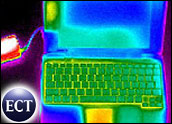
Furthering its unique technology that uses on-chip software to economize processor energy, Transmeta has introduced the Efficeon TM8000 family of chips, which the company hopes will broaden its markets.
The new Efficeon TM8000, announced at the Microprocessor Forum in San Jose, California, builds on the original energy-efficient Crusoe processor and is designed to take efficient computing “to a new level,” the Santa Clara, California-based company said.
Few doubt the technological prowess of the x86-compatible Efficeon, which employs the next generation of the company’s “code-morphing software” and “thermal-management technology” to reduce power consumption. The true test will be finding the right products for the chip, which Transmeta said is aimed at blade servers and embedded systems in addition to the company’s existing niche of ultralight notebook computers.
“Efficeon is really focused on the light and thin market, which is two-thirds of the notebook market,” IDC research director Alan Promisel told TechNewsWorld. “If anything, they’re changing their focus to a more mainstream commercial market.”
Architecture Step
Calling the Efficeon TM8000 a “major leap forward for CPU performance for Transmeta,” company cofounder and CTO David Ditzel said Efficeon’s architectural improvements — a 256-bit engine capable of eight internal instructions per clock cycle and redesigned code-morphing software — will push the chip into new markets.
In addition to the 256-bit very long instruction word (VLIW) engine, the Efficeon technology also features new graphics and memory interfaces, including the HyperTransport interconnect that can send data at up to 1.6 GB per second — as much as 12 times faster than Crusoe’s interface throughput.
Gartner research vice president Martin Reynolds told TechNewsWorld that the Efficeon improvements are all extensions of existing technology, but he added that Transmeta’s underlying technology remains unique.
Power-Saving Performance
Transmeta designed the Efficeon technology to decrease the size and cost of the PC board for smaller form factors by integrating Northbridge core logic on the chip, which can help the processor communicate more efficiently with other elements of the computer, Transmeta said.
The new family of processors also features LongRun2, a new version of Transmeta’s power and thermal management technology that reduces transistor leakage. Reynolds said that although one might expect problems as a result of proprietary software running on the chip, the Transmeta software uses resources that otherwise would be wasted.
The end result, according to Reynolds, is that the chip has more flexibility. “It’s just an amazing product in terms of what it does,” he said. “The challenge is finding the right products for it.”
Small Markets Get Big
Reynolds, who discounted some views of Transmeta as a struggling company competing against AMD and Intel, said investors are likely to wait and watch Efficeon’s deployment and success.
“It may hit the jackpot at some point,” he said. “In five years, we may find that Transmeta has uncovered a new market — the smallest form factor you can imagine. If [Efficeon] finds its way into cell phones, it could be all over the place.”
While he conceded that Transmeta has not been able to keep up with Intel — which has heavily marketed its Centrino mobile chips — in terms of performance, Reynolds said the efficiency-performance tradeoff does not matter in the small devices for which Efficeon is intended.
Energy Value
IDC’s Promisel said Efficeon is unlikely to catch on in the consumer space, where price and performance are still the biggest factors.
However, on the commercial side, there is a shift in focus toward energy efficiency because of its link to productivity, Promisel added.
“If organizations invest in portable PCs, the idea is they will make their money back in additional productivity,” he explained.
“An efficient processor is critical to delivering any additional productivity because without it, the value proposition goes out the window. Being restricted to an AC power environment or limited to when you can or can’t use it is not going to deliver productivity gains.”





















































